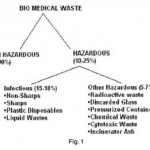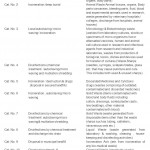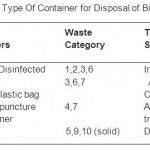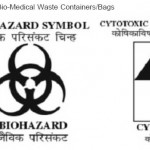Need of Biomedical Waste Management System in Hospitals - An Emerging issue - A Review
Praveen Mathur1 , Sangeeta Patan1 * and Anand S. Shobhawat1
DOI: http://dx.doi.org/10.12944/CWE.7.1.18
Medical care is vital for our life and health, but the waste generated from medical activities represents a real problem of living nature and human world. Improper management of waste generated in health care facilities causes a direct health impact on the community, the health care workers and on the environment Every day, relatively large amount of potentially infectious and hazardous waste are generated in the health care hospitals and facilities around the world. Indiscriminate disposal of BMW or hospital waste and exposure to such waste possess serious threat to environment and to human health that requires specific treatment and management prior to its final disposal. The present review article deals with the basic issues as definition, categories, problems relating to biomedical waste and procedure of handling and disposal method of Biomedical Waste Management. It also intends to create awareness amongst the personnel involved in health care unit.
Copy the following to cite this article:
Mathur P, Patan S, Shobhawat S. Need of Biomedical Waste Management System in Hospitals - An Emerging issue - A Review. Curr World Environ 2012;7(1):117-124 DOI:http://dx.doi.org/10.12944/CWE.7.1.18
Copy the following to cite this URL:
Mathur P, Patan S, Shobhawat S. Need of Biomedical Waste Management System in Hospitals - An Emerging issue - A Review. Curr World Environ 2012;7(1):117-124. Available from: http://www.cwejournal.org/?p=1969
Download article (pdf)
Citation Manager
Publish History
Select type of program for download
| Endnote EndNote format (Mac & Win) | |
| Reference Manager Ris format (Win only) | |
| Procite Ris format (Win only) | |
| Medlars Format | |
| RefWorks Format RefWorks format (Mac & Win) | |
| BibTex Format BibTex format (Mac & Win) |
Article Publishing History
| Received: | 2012-04-24 |
|---|---|
| Accepted: | 2012-05-27 |
Introduction
Biomedical waste management has recently emerged as an issue of major concern not only to hospitals, nursing home authorities but also to the environment. the bio-medical wastes generated from health care units depend upon a number of factors such as waste management methods, type of health care units, occupancy of healthcare units, specialization of healthcare units, ratio of reusable items in use, availability of infrastructure and resources etc.1
The proper management of biomedical waste has become a worldwide humanitarian topic today. Although hazards of poor management of biomedical waste have aroused the concern world over, especially in the light of its far-reaching effects on human, health and the environment.2
Now it is a well established fact that there are many adverse and harmful effects to the environment including human beings which are caused by the “Hospital waste” generated during the patient care. Hospital waste is a potential health hazard to the health care workers, public and flora and fauna of the area. The problems of the waste disposal in the hospitals and other health-care institutions have become issues of increasing concern.3
Definition
According to Biomedical Waste (Management and Handling) Rules, 1998 of India “Any waste which is generated during the diagnosis, treatment or immunization of human beings or animals or in research activities pertaining thereto or in the production or testing of biologicals.4
The Government of India (notification, 1998) specifies that Hospital Waste Management is a part of hospital hygiene and maintenance activities. This involves management of range of activities, which are mainly engineering functions, such as collection, transportation, operation or treatment of processing systems, and disposal of wastes.4
One of India’s major achievements has been to change the attitudes of the operators of health care facilities to incorporate good HCW management practices in their daily operations and to purchase on-site waste management services from the private sector. (Bekir Onursal, 2003)
World Health Organization states that 85% of hospital wastes are actually non-hazardous, whereas 10% are infectious and 5% are non-infectious but they are included in hazardous wastes. About 15% to 35% of Hospital waste is regulated as infectious waste. This range is dependent on the total amount of waste generated (Glenn and Garwal, 1999).5
Classification of Bio-Medical Waste
The World Health Organization (WHO) has classified medical waste into eight categories:
´ General Waste
´ Pathological
´ Radioactive
´ Chemical
´ Infectious to potentially infectious waste
´ Sharps
´ Pharmaceuticals
´ Pressurized containers
Sources of Biomedical Waste
Hospitals produce waste, which is increasing over the years in its amount and type. The hospital waste, in addition to the risk for patients and personnel who handle them also poses a threat to public health and environment.
Major Sources
- Govt. hospitals/private hospitals/nursing homes/ dispensaries.
- Primary health centers.
- Medical colleges and research centers/ paramedic services.
- Veterinary colleges and animal research centers.
- Blood banks/mortuaries/autopsy centers.
- Biotechnology institutions.
- Production units.
Minor Sources
- Physicians/ dentists’ clinics
- Animal houses/slaughter houses.
- Blood donation camps.
- Vaccination centers.
- Acupuncturists/psychiatric clinics/cosmetic piercing.
- Funeral services.
- Institutions for disabled persons
Problems relating to biomedical waste
A major issue related to current Bio-Medical waste management in many hospitals is that the implementation of Bio-Waste regulation is unsatisfactory as some hospitals are disposing of waste in a haphazard, improper and indiscriminate manner. Lack of segregation practices, results in mixing of hospital wastes with general waste making the whole waste stream hazardous. Inappropriate segregation ultimately results in an incorrect method of waste disposal.
Inadequate Bio-Medical waste management thus will cause environmental pollution, unpleasant smell, growth and multiplication of vectors like insects, rodents and worms and may lead to the transmission of diseases like typhoid, cholera, hepatitis and AIDS through injuries from syringes and needles contaminated with human.6
Various communicable diseases, which spread through water, sweat, blood, body fluids and contaminated organs, are important to be prevented. The Bio Medical Waste scattered in and around the hospitals invites flies, insects, rodents, cats and dogs that are responsible for the spread of communication disease like plague and rabies. Rag pickers in the hospital, sorting out the garbage are at a risk of getting tetanus and HIV infections. The recycling of disposable syringes, needles, IV sets and other article like glass bottles without proper sterilization are responsible for Hepatitis, HIV, and other viral diseases. It becomes primary responsibility of Health administrators to manage hospital waste in most safe and eco-friendly manner.6
The problem of bio-medical waste disposal in the hospitals and other healthcare establishments has become an issue of increasing concern, prompting hospital administration to seek new ways of scientific, safe and cost effective management of the waste, and keeping their personnel informed about the advances in this area. The need of proper hospital waste management system is of prime importance and is an essential component of quality assurance in hospitals.
 |
Figure 1: Click here to View figure |
Need of Biomedical waste Management in Hospitals
The reasons due to which there is great need of management of hospitals waste such as:
- Injuries from sharps leading to infection to all categories of hospital personnel and waste handler.
- nosocomial infections in patients from poor infection control practices and poor waste management.
- Risk of infection outside hospital for waste handlers and scavengers and at time general public living in the vicinity of hospitals.
- Risk associated with hazardous chemicals, drugs to persons handling wastes at all levels.
- “Disposable” being repacked and sold by unscrupulous elements without even being washed.
- Drugs which have been disposed of, being repacked and sold off to unsuspecting buyers.
- Risk of air, water and soil pollution directly due to waste, or due to defective incineration emissions and ash.3
Biomedical Waste Management Process
There is a big network of Health Care Institutions in India. The hospital waste like body parts, organs, tissues, blood and body fluids along with soiled linen, cotton, bandage and plaster casts from infected and contaminated areas are very essential to be properly collected, segregated, stored, transported, treated and disposed of in safe manner to prevent nosocomial or hospital acquired infection.
- Waste collection
- Segregation
- Transportation and storage
- Treatment & Disposal
- Transport to final disposal site
- Final disposal
Biomedical Waste Treatment and Disposal
Health care waste is a heterogeneous mixture, which is very difficult to manage as such. But the problem can be simplified and its dimension reduced considerably if a proper management system is planned.
Incineration Technology
This is a high temperature thermal process employing combustion of the waste under controlled condition for converting them into inert material and gases. Incinerators can be oil fired or electrically powered or a combination thereof. Broadly, three types of incinerators are used for hospital waste: multiple hearth type, rotary kiln and controlled air types. All the types can have primary and secondary combustion chambers to ensure optimal combustion. These are refractory lined.7
Non-Incineration Technology
Non-incineration treatment includes four basic processes: thermal, chemical, irradiative, and biological. The majority of non-incineration technologies employ the thermal and chemical processes. The main purpose of the treatment technology is to decontaminate waste by destroying pathogens. Facilities should make certain that the technology could meet state criteria for disinfection.9
Autoclaving
´ The autoclave operates on the principle of the standard pressure cooker.
´ The process involves using steam at high temperatures.
´ The steam generated at high temperature penetrates waste material and kills all the micro organism
´ These are also of three types: Gravity type, Pre-vacuum type and Retort type.
In the first type (Gravity type), air is evacuated with the help of gravity alone. The system operates with temperature of 121 deg. C. and steam pressure of15 psi. for 60-90 minutes. Vacuum pumps are used to evacuate air from the Pre vacuum autoclave system so that the time cycle is reduced to 30-60 minutes. It operates at about 132 deg. C. Retort type autoclaves are designed much higher steam temperature and pressure. Autoclave treatment has been recommended for microbiology and biotechnology waste, waste sharps, soiled and solid wastes. This technology renders certain categories (mentioned in the rules) of bio-medical waste innocuous and unrecognizable so that the treated residue can be land filled.8
Microwave Irradiation
´ The microwave is based on the principle of generation of high frequency waves.
´ These waves cause the particles within the waste material to vibrate, generating heat.
´ This heat generated from within kills all pathogens.
Chemical Methods
´ 1 % hypochlorite solution can be used for chemical disinfection
Plasma Pyrolysis
Plasma pyrolysis is a state-of-the-art technology for safe disposal of medical waste. It is an environment-friendly technology, which converts organic waste into commercially useful byproducts. The intense heat generated by the plasma enables it to dispose all types of waste including municipal solid waste, biomedical waste and hazardous waste in a safe and reliable manner. Medical waste is pyrolysed into CO, H2, and hydrocarbons when it comes in contact with the plasma-arc. These gases are burned and produce a high temperature (around 1200oC).9
Biomedical Waste Management Rules
Safe disposal of biomedical waste is now a legal requirement in India. The Biomedical Waste Management & Handling) Rules, 1998 came into force on 1998. In accordance with these rules, it is the duty of every “occupier” i.e. a person who has the control over the institution or its premises, to take all steps to ensure that waste generated is handled without any adverse effect to human health and environment. It consists of six schedules.
Schedule I
Schedule II
Schedule III
Schedule IV
Schedule V
Schedule VI
 |
Schedule I: Categories of Bio-Medical Waste Click here to View schedule |
 |
Schedule II: Colour Coding and Type of Container for Disposal of Bio-Medical Wastes Click here to View schedule |
 |
Schedule III: Label for Bio-Medical Waste Containers/Bags Click here to View schedule |
Schedule IV
Label for Transport of Bio-Medical Waste Containers/Bags
Day ………… Month ………….......Year ………......
Date of generation ……………….............................
Waste category No ……..
Waste class
Waste description
Sender’s Name & Address Receiver’s Name & Address
Phone No …..........…... Phone No .......……………
Telex No …...................Telex No ……..........………
Fax No ……………....... Fax No ………...........……..
Contact Person ……................................................... Contact Person ………
In case of emergency please contact Name & Address:
Phone No.
Note: Label shall be non-washable and prominently visible.
Schedule-V
Standards for Treatment and Disposal Of Bio-Medical Wastes Standards For Incinerators
Schedule-VI
Schedule for Waste Treatment Facilities like Incinerator/ Autoclave/ Microwave System.10 (Source- The Bio Medical Waste (Management and Handling) Rules, 1998).
Benefits of Biomedical Waste Management
´ Cleaner and healthier surroundings.
´ Reduction in the incidence of hospital acquired and general infections.
´ Reduction in the cost of infection control within the hospital.
´ Reduction in the possibility of disease and death due to reuse and repackaging of infectious disposables.
´ Low incidence of community and occupational health hazards.
´ Reduction in the cost of waste management and generation of revenue through appropriate treatment and disposal of waste.
´ Improved image of the healthcare establishment and increase the quality of life.
Recommendations
- For the use of incinerator Training should be given to some number of persons from staff.
- Specific fund should be allocated for the use of incinerator.
- Every hospital should have special boxes to use as dustbin for bio-medical waste.
- Bio-medical waste should not be mixed with other waste of Municipal Corporation.
- Private hospitals should also be allowed to use incinerator, which is installed, in govt. hospital. For this purpose a specific fee can be charged from private hospitals.
- Special vehicle i.e. bio-medical waste vehicle should be started to collect waste from private hospitals and private medical clinics and carry it up to the main incinerator.
- As provided by bio-medical waste rules, the whole of the waste should be fragmented into colours due to their hazardous nature.
- Bio-medical waste Management Board can be established in each District.
- Either judicial powers should be given to the management board or special court should be established in the matters of environment pollution for imposing fines and awarding damages etc.
- Housekeeping staff wear protective devices such as gloves, face masks, gowned, while handling the waste.
- There is biomedical waste label on waste carry bags and waste carry trolley and also poster has put on the wall adjacent to the bins (waste) giving details about the type of waste that has to dispose in the baggage as per biomedical waste management rule. Carry bags also have the biohazard symbol on them.
Conclusion
Medical wastes should be classified according to their source, typology and risk factors associated with their handling, storage and ultimate disposal. The segregation of waste at source is the key step and reduction, reuse and recycling should be considered in proper perspectives. We need to consider innovative and radical measures to clean up the distressing picture of lack of civic concern on the part of hospitals and slackness in government implementation of bare minimum of rules, as waste generation particularly biomedical waste imposes increasing direct and indirect costs on society. The challenge before us, therefore, is to scientifically manage growing quantities of biomedical waste that go beyond past practices. If we want to protect our environment and health of community we must sensitize our selves to this important issue not only in the interest of health managers but also in the interest of community.
References
- Mandal S. K. and Dutta J. , Integrated Bio-Medical Waste Management Plan for Patna City, Institute of Town Planners, India Journal 6-2: 01-25 (2009).
- Singh V. P., Biswas G., and Sharma, J. J., Biomedical Waste Management - An Emerging Concern in Indian Hospitals Indian, Journal of Forensic Medicine & Toxicology, Vol. 1, No. 1. (2007-12).
- Hem Chandra, Hospital Waste an Environmental Hazard and Its Management, (1999).
- Govt. of India, Ministry of Environment and Forests Gazette notification No 460 dated July 27, New Delhi: 1998: 10-20
- Glenn, Mc.R & Garwal, R. Clinical waste in Developing Countries. An analysis with a Case Study of India, and a Critique of the BasleTWG Guidelines (1999)
- CEET: Biomedical Waste Management-Burgeoning issue (2008)
- Gravers PD. Management of Hospital Wastes- An overview. Proceedings of National workshop on Management of Hospital Waste,(1998)
- Thornton J., Tally MC, Orris P., Wentreg J. Hospitals and plastics Dioxin prevention and Medical Waste Incineration; Public Health Reports. 1996; 1:299- 313.
- Surjit S. Katoch Biomedical Waste Classification and Prevailing Management Strategies, Proceedings of the International Conference on Sustainable Solid Waste Management, p. p.169-175 (2007).
- The Bio Medical Waste (Management and Handling) Rules, (1998).
- Dr. Saurabh Sikka, Biomedical Waste inIndian Context.
- Shalini Sharma* and S.V.S.Chauhan, Assessment of bio-medical waste management in three apex Government hospitals of Agra, Journal of Environmental Biology, 29(2), p. p 159-162 (2008)
- Bekir Onursal, Health Care Waste Management in India. The world Bank (2003).






